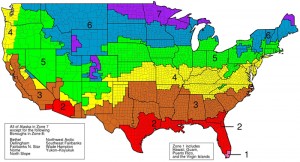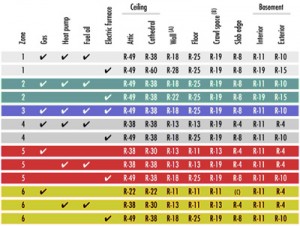Insulation is rated in terms of thermal resistance, called the R-value, which indicates the insulation’s resistance to heat flow. The higher the R-value, the greater the insulating effectiveness, and thus lower utility bills for your home!
Know Your R-Value!
 Every area in your home has a recommended R-value, which is the insulation material’s resistance to heat flow. It may not be a conversation your contractor wants to have with you, but one well worth the time and in the long haul – well worth the money. Contractors can dazzle homeowners with top-of-the-line furnaces, wood burning stoves and fireplaces, but none of that will matter if the insulation isn’t adequate enough to keep the heat in.
Every area in your home has a recommended R-value, which is the insulation material’s resistance to heat flow. It may not be a conversation your contractor wants to have with you, but one well worth the time and in the long haul – well worth the money. Contractors can dazzle homeowners with top-of-the-line furnaces, wood burning stoves and fireplaces, but none of that will matter if the insulation isn’t adequate enough to keep the heat in.
Some key areas to know your R-value are your exterior walls, which should have a R-value of at least 19, sloped and cathedral ceilings should range from R-30 to R-38, an unheated attic should be a R-38 and the joist cavity under your floor should range from R-11 to R-30. It is essential that the entire joist cavity be filled with insulation, because any air gaps will greatly reduce the R-value in that room. The same is true when you’re insulating your basement – fill in the gaps, otherwise moisture will find its way through. The area you’re insulating is called the rim joist, which is the area above the concrete wall between the joists in the basement ceiling and between floors in two story homes.
 Don’t forget about insulating your heating ducts, especially if you live in a cooler climate and have a furnace or heat pump. You can lose up to one-third of your heat through poorly insulated, leaky ductwork. For areas which are unheated like the attic, crawl space or basement (in some cases) you can get away with using a R-8 to insulate your ducts.
Don’t forget about insulating your heating ducts, especially if you live in a cooler climate and have a furnace or heat pump. You can lose up to one-third of your heat through poorly insulated, leaky ductwork. For areas which are unheated like the attic, crawl space or basement (in some cases) you can get away with using a R-8 to insulate your ducts.
Moisture is another area of concern, because water greatly reduces the effectiveness of insulation and can breed mold, insects and rot. You wouldn’t think this would be a concern in a new home, but the moisture you need to worry about comes from inside your home – from cooking, bathing and cleaning. The moisture moves into your wall and ceiling cavities via the air, which is why it is recommended to use batt insulation wrapped in foil or kraft paper to serve as a barrier against moisture.
Don’t forget about your water pipes! They should be wrapped with a R-3 insulation to protect them from freezing in the winter and to help keep the hot water hot.
| Zone | Add Insulation to Attic | Floor | |
| Uninsulated Attic | Existing 3–4 Inches of Insulation | ||
| 1 | R30 to R49 | R25 to R30 | R13 |
| 2 | R30 to R60 | R25 to R38 | R13 to R19 |
| 3 | R30 to R60 | R25 to R38 | R19 to R25 |
| 4 | R38 to R60 | R38 | R25 to R30 |
| 5 to 8 | R49 to R60 | R38 to R49 | R25 to R30 |







Follow Us!